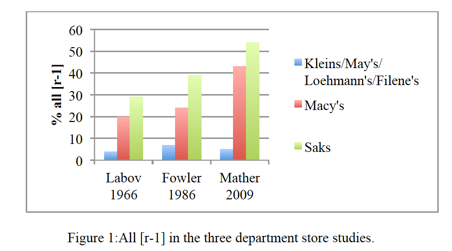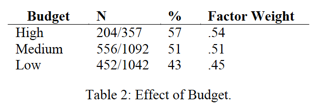NYC rhoticity
« previous post | next post »
"Can you spot wealthy New Yorkers by their ‘R” sounds?", Improbable Blog 6/19/2015:
Is it possible to gauge how wealthy a New Yorker might be just by the way they pronounce their /r/ s? A new paper in the Journal of English Linguistics investigates whether variations of rhoticity [viz. the prevalence, or lack of, the /r/ sound in speech] in wedding-consultants’ speech could be correlated with the amount of money a bride states she is willing to spend on her wedding dress. That is to say, the amount of money she has at her disposal, used as a measure of her (perceived) social status. The paper, in the Journal of English Linguistics, June 2015, 43: 118-142, can be downloaded here for US$30: Maeve Eberhardt & Corinne Downs, "'(r) You Saying Yes to the Dress?' Rhoticity on a Bridal Reality Television Show", Journal of English Linguistics 2015.
Or you can deprive Sage Publications of their $30, and get a report about the same research for free in an earlier version: Maeve Eberhardt & Corinne Downs, "A Department Store Study for the 21st Century: /r/ vocalization on TLC’s Say Yes to the Dress", NWAV 2013.
The NWAV 2013 paper's abstract:
This paper focuses on /r/ vocalization on the reality television show Say Yes to the Dress, which features an upscale bridal salon in New York City. The study examines five bridal consultants working at Kleinfeld Bridal in Manhattan. Using the brides’ budgets as a proxy for social status, we investigate whether variation in consultants’ use of /r/ correlates with the amount of money brides state they are willing to spend on their dress, which ranges from $1,000 to unlimited. A mixed-effects model in Rbrul shows significant differences across three budget categories. We argue that although there are important methodological differences, our findings parallel Labov’s original department store study as well as later replications. Additionally, qualitative examination of show excerpts suggests that variation in /r/ may be recruited in performing particular interactional roles, as consultants use clusters of [r-1] or [r-0], depending on the positioning taken in a given interaction.
The Say Yes to the Dress effects seem to be substantially smaller than the department-store effects, though — here are the results of three "rapid anonymous surveys" of employees at three stories differing in socio-economic status:

The basic technique was to ask the employees something like "where can I find X?", where the experimenter knew in advance that X was located on the fourth floor.
And here's the table of Kleinfeld consultant's rhoticity as a function of bride's budget:

Presumably the department-store effect is greater because the employees at Saks vs. Kleins etc. are selected (or osmotically trained) to speak in a consistent style, whereas Kleinfeld's consultants are modulating their speech style to suit their perception of customer's status, in a situation where even the lowest-level customers are spending a lot of money.
(And also, the "fourth floor" context is one that tends to maximize /r/ vocalization, whereas the Say Yes to the Dress data covers a larger range of syllable-final /r/ words.)
cameron said,
June 23, 2015 @ 6:21 pm
"Department Store Study" – is there any other study in any field of linguistics that's so classic and widely known that it can serve as the paradigm for a whole genre of studies not by direct reference, but by metonymic reference to an aspect of the study.
David Donnell said,
June 24, 2015 @ 1:27 am
Not sure about rhoticity specifically, but recently—crossing the Williamsburg Bridge on an M train from Manhattan to Bklyn, heading towards home in Ridgewood, Queens—I nudged my 8-yr-old son & 10-yr-old daughter to stand close to a couple of girlwomen whom I suspected—based on the kind of English I heard them speaking—would be getting off the train at the first stop in Brooklyn, where most of the moneyed, trust-fund-endowed young people live. (I wanted us to snag their subway seats when they got off!)
And when those two young women abruptly got off the train at that Marcy Ave stop, my daughter asked me, all amazed-like, “How did you KNOW THAT, daddy?!”
Suddenly, feeling self-conscious, I was struck with a moral quandary: do I reveal to my tiny kids how ‘accents’ speak volumes about ‘money’, or not?? (Parental advice appreciated!)
Ken Miner said,
June 24, 2015 @ 2:56 am
Parental advice: speakers can change only features of their speech that they're aware of. So be sure your kids major in linguistics!
I was an undergraduate at City College in the 60s. The only real linguist on the faculty was Louis Heller, a comparatist, so I had to get my phonetics in the Speech Department, which had had a long-standing tradition of trying to get students to stop "honking" (i. e., sounding like New Yorkers, which of course involved r-lessness).The tradition was tapering off when I was there, but I've often wondered whether all those years of CCNY speech training actually had any effect. It might be part of the mix.
George said,
June 24, 2015 @ 3:10 am
OK, this isn't exactly language-related, but it strikes me that in Ireland at least (unless we're talking about the really wealthy), "the amount of money a bride states she is willing to spend on her wedding dress" would probably not correlate positively with the amount of money really at her disposal (as opposed to the amount of money her family can scrape together by foregoing other things or getting into debt) and certainly wouldn't correlate with 'social status'. If anything, the correlation would be negative…
George said,
June 24, 2015 @ 3:12 am
There was a second 'positively' missing there.
J.W. Brewer said,
June 24, 2015 @ 8:07 am
I thought the more interesting result (from the non-gated version) was that of the five salesladies studied, three were more likely to be non-rhotic when the customer was non-rhotic but the other two exhibited increased rhoticity when interacting with non-rhotic customers. (A better study would be not at the Manhattan location the reality-tv people used but at the Kleinfel's "mother ship" location way out in Brooklyn which I've been told via traveler's tales is quite a spectacular place for informal sociological data-collection on the intersections of class/money/ethnicity/etc in the NYC area.)
J.W. Brewer said,
June 24, 2015 @ 10:29 am
http://linguistics-research-digest.blogspot.com/2013/06/revisiting-new-york-department-stores.html summarizes Mather's recent redo of the original experiment (I'm assuming the whole paper is not online for free, but would be happy to be shown a link if I'm wrong about that), with intervening changes both in language use in NYC more generally and in the racial/ethnic mix of department store employees.